Snake plants, also known as Sansevieria, are popular for their hardy nature and their ability to thrive in a variety of indoor environments. However, like any other plant, they can suffer if not cared for properly.
One common problem encountered by snake plant owners is overwatering, which can lead to several negative effects. In this article, we will discuss how to fix an overwatered snake plant.
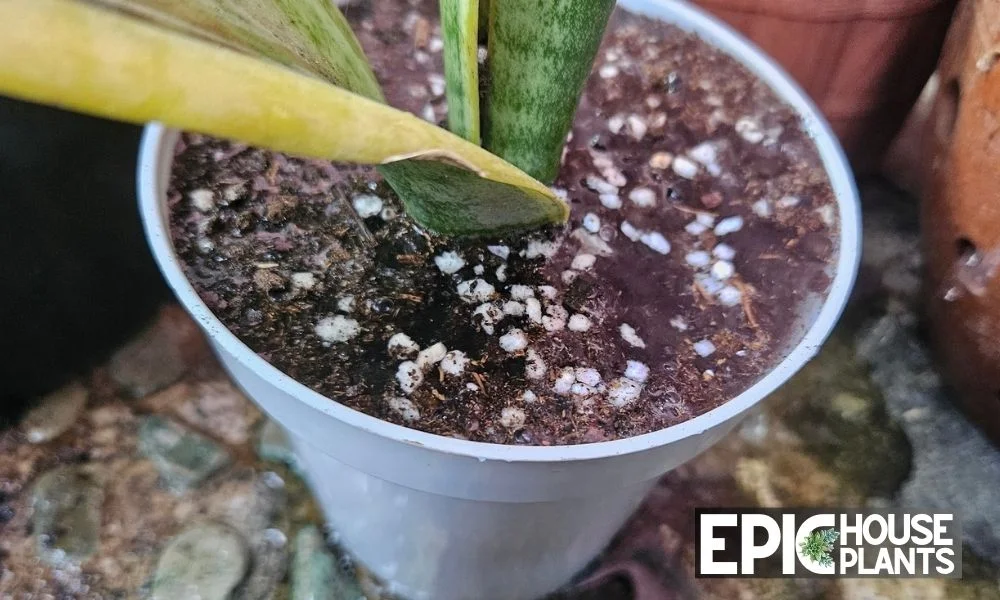
Signs of an Overwatered Snake Plant
Understanding the signs of an overwatered snake plant is crucial in taking corrective measures promptly. Here are the key signs:
Snake Plant Leaves Turning Yellow and Soft
When a snake plant is overwatered, its leaves begin to turn yellow or brown due to the lack of nutrients absorption from the waterlogged roots. The leaves may also appear wilted as the discoloration spreads.
Leaves Drooping
If the sturdy leaves of the snake plant start to droop, it’s a clear sign of water logging at the roots. The affected leaves will also become limp and soft to touch, and the branch to which they are attached may eventually dry and die out.
Soggy or Mushy Leaves
When the leaves of the snake plant turn soggy or mushy, it’s an indication that the plant has been overwatered. These leaves will also become dull green and may even develop brown tips.
💡Also Read: You will also notice these squishy leaves becoming a duller shade of green with brown tips. Read more about Snake Plant Leaves Splitting here.
Mold on Snake Plant
Overwatered snake plants in poor ventilation areas are susceptible to gray mold growth, which spreads over the foliage over time. If not treated, this mold can also spread through spores to nearby plants.
Rotten and Loose Roots
Excessive watering can lead to the roots developing fungal and bacterial infections, causing them to rot. Upon inspection, overwatered snake plants will have roots that are weak and loose due to oxygen deprivation.
Soil with White Patches
White patches at the base of the plant are indicative of overwatering. These patches could be mold or fungal growth that thrive in damp environments.
Algae breeding, another condition promoted by overwatering, can significantly hamper the plant’s health, leading to the foliage appearing weak and limp.
Unpleasant Smell
An overwatered snake plant will eventually emit an unpleasant odor if the root rot gets worse. There will be a strong, unpleasant scent coming from the roots, signaling that immediate intervention is needed.
Causes of Overwatering
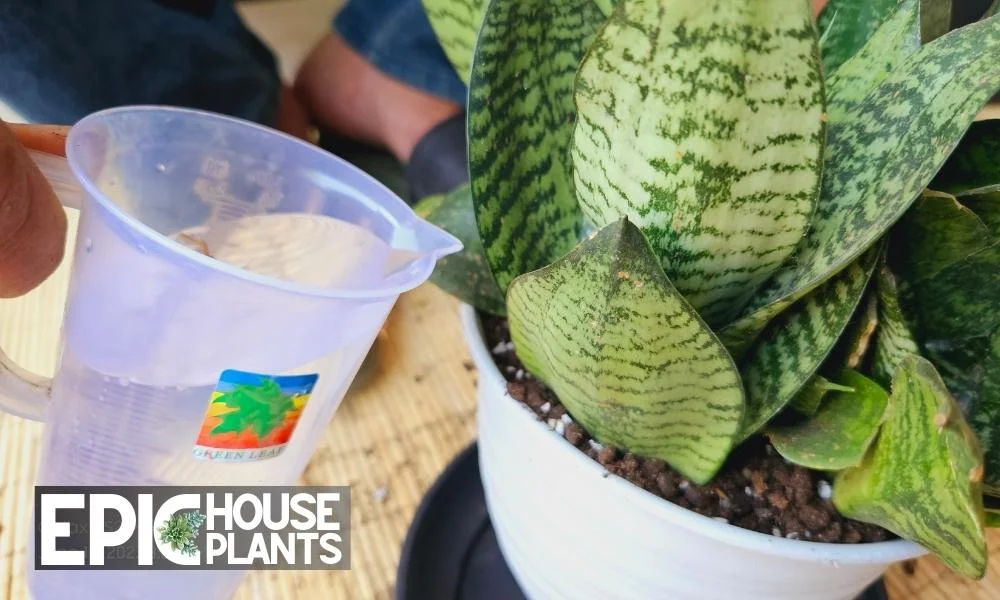
Before we delve into the solution, it is vital to understand the reasons behind overwatering. We will break down each cause in a table format for better comprehension.
Here are the causes of overwatering, illustrated in a table form:
| Causes | Description |
|---|---|
| Frequent Watering | Watering the plant too frequently leads to waterlogged soil and root rot. It is advisable to water snake plants sparingly to avoid this. |
| Overlooking Drainage Issue | Small pebbles can clog the drain holes, leading to water accumulation at the bottom of the pot, resulting in overwatering. Regularly check and clean your drain holes. |
| Inappropriate Potting Soil | The type of soil can affect water retention and drainage. Heavy soil like clay retains too much water and lacks proper drainage, contributing to overwatering. Check our guide on the 7 Best Soil for Snake Plant for better choices. |
| High Humidity | Snake plants prefer a dry environment. If kept in an overly humid environment, the plant may absorb too much moisture, leading to overwatering. |
| Oversized Pot | A pot that is too large will hold too much water, potentially causing overwatering. Snake plants should be grown in a pot just slightly larger than the root ball of the plant. |
| Low Light | Snake plants require occasional watering, especially when they have not been receiving enough sunlight, which can evaporate some moisture from the soil surface. Read more about snake plant’s light requirement here. |
How to Save an Overwatered Snake Plant
This section will provide you with a detailed guide on how to save your overwatered snake plant.
Step 1: Identifying Signs of Overwatering
The first step in saving an overwatered snake plant is identifying the signs of overwatering.
It’s crucial to pinpoint the issue accurately, as overwatering symptoms can sometimes mimic those of overfertilization or cold damage.
Common signs of overwatering include yellowing leaves, wilting, or drooping foliage. In severe cases, you might notice an unpleasant smell from the plant’s roots due to root rot.
Swift action is vital to prevent further damage and start the plant on its recovery journey.
💡Also Read: For a more in-depth look at watering your snake plant correctly, our article on How Often to Water Snake Plant can offer more insights.
Step 2: Stop Watering
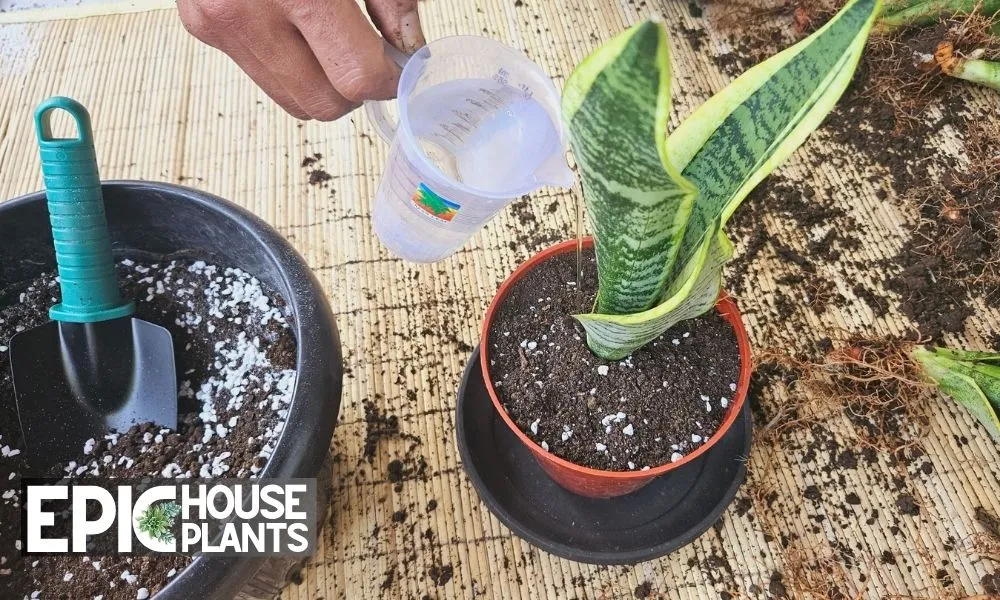
When dealing with an overwatered snake plant, it’s essential to halt watering immediately. This will prevent additional water damage and give the plant time to recover.
Snake plants are succulents and can withstand periods without water, allowing them to bounce back from overwatering with appropriate care.
Step 3: Remove the Snake Plant from the Pot

After stopping watering, the next step is to gently remove the snake plant from its pot. Start by lightly tapping the sides of the pot to loosen the soil. Once loose enough, gently lift the plant from the pot, taking care not to damage the roots.
Step 4: Look for Signs of Root Rot
With the plant removed, it’s time to examine the roots for signs of root rot—a fungal infection that thrives in waterlogged conditions.
Affected roots often appear soggy, emit an unpleasant odor, and may have brown or black spots. Conduct a thorough examination to ensure you don’t miss any affected areas.
Step 5: Treating Root Rot

Next, rinse off any excess soil from the roots, enabling you to get a clear picture of the damage. Using sterile pruning shears, carefully cut away any infected roots, ensuring you leave only the healthy ones intact.
Remember, if you don’t remove all the affected roots, the rot could spread again.
Once you’ve removed the unhealthy roots, apply a fungicide to the remaining root system, following the manufacturer’s instructions. This will help combat any lingering fungus and protect the plant’s future health.
Finally, let the roots air-dry for a few days to form a protective callus, further safeguarding against pests or fungal attacks.
Step 6: Repotting Snake Plant Using Fresh Soil
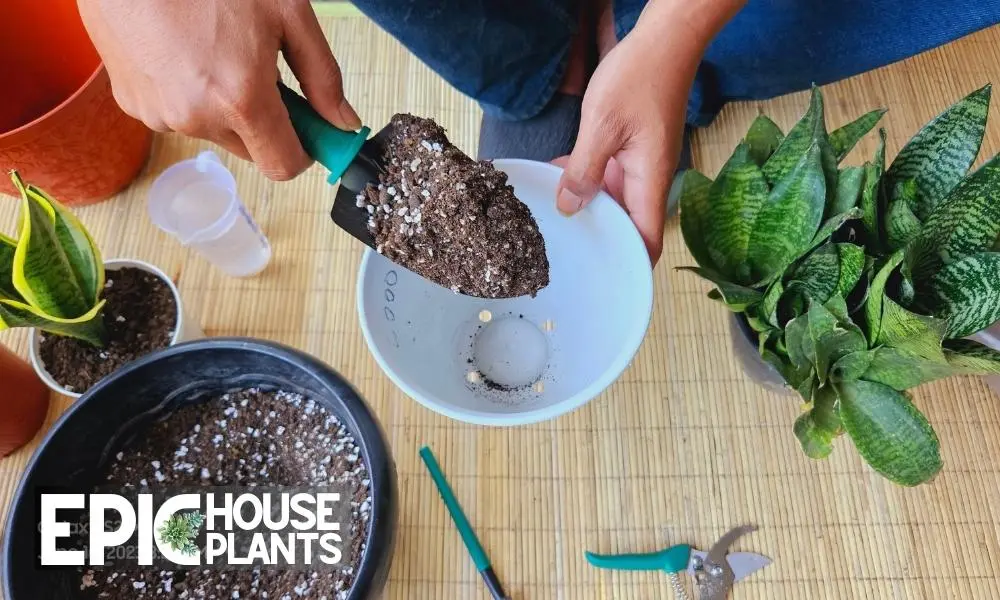
Now that your snake plant’s roots are healthy, it’s time to repot the plant using fresh, well-draining soil.
This step ensures that your plant has an optimal environment for recovery and future growth. Place the plant gently into the new pot, taking care not to damage the freshly pruned roots.
After repotting, wait for a few days before you start watering the plant again. This will allow it to settle in the new soil and adjust to its fresh start.
Author Note:
Remember, prevention is better than cure; always ensure you provide the right watering conditions for your snake plant to avoid overwatering issues.
💡Also Read: For a more detailed guide on how to repot your snake plant properly, check out our article on Repotting Snake Plant Like a Pro.
Step 7: Post-care
Once your snake plant is repotted and on its way to recovery, it’s essential to take preventative measures to avoid a recurrence of overwatering.
Water your snake plant sparingly. These plants are succulents and can survive longer periods without water. It’s better to underwater than overwater a snake plant.
Ensure the pot you use for your snake plant has sufficient drainage. This will allow excess water to escape, preventing waterlogging and root rot. Similarly, use well-draining soil to provide your snake plant with the best environment for growth.
Step 8: Monitoring
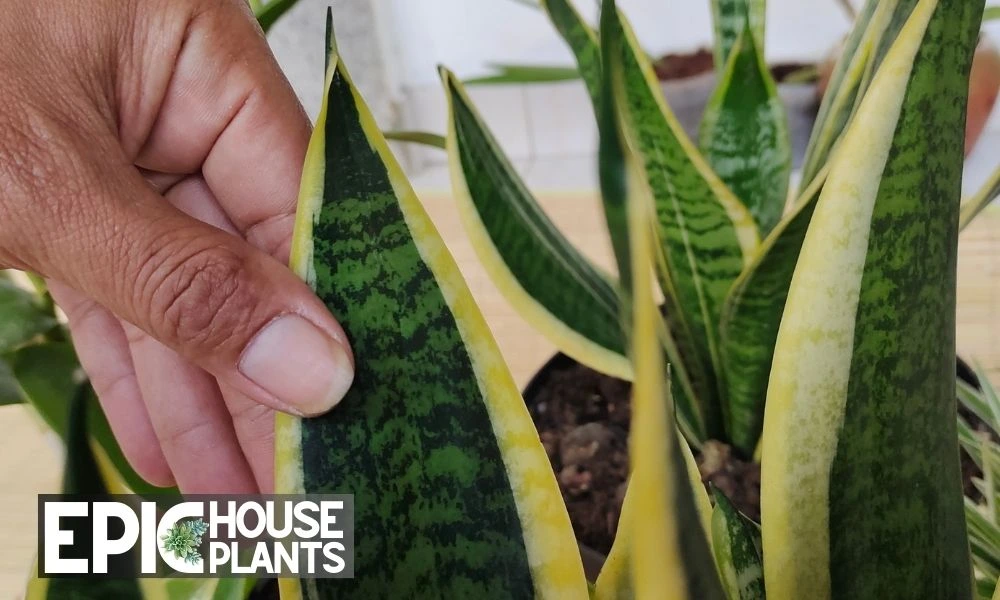
Monitor your plant closely over the next few weeks. Look out for signs of new growth, which is a good indicator that your plant is recovering.
However, if you notice any signs of continuing deterioration, you may need to repeat the above process or consult with a plant expert.
Step 9: Gradual Watering
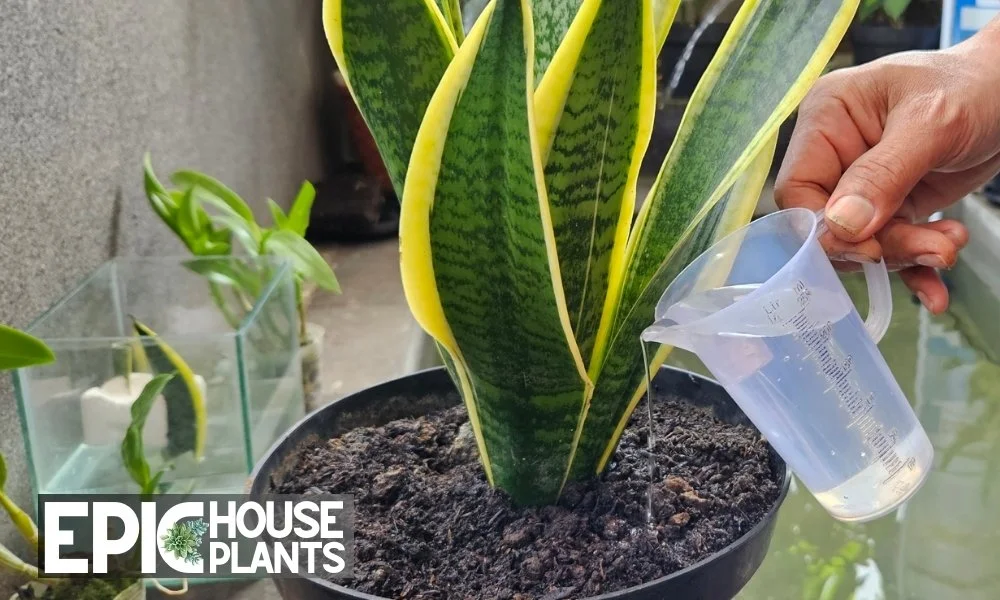
Once the snake plant shows signs of recovery, slowly reintroduce watering. Begin by watering your plant sparingly, only when the soil is completely dry.
Gradually increase the watering frequency, but ensure you never overwater. Remember, snake plants prefer drier conditions.
Rescuing an overwatered snake plant is not always an easy task, but with these steps, you’ll stand a good chance of bringing your snake plant back to health.
Remember, every plant is unique and may require slightly different care. The key is to remain observant, be patient, and not to lose hope—your green friend is resilient and can bounce back with a bit of care and attention.
Author Note:
By following these steps, you should be able to restore your plant back to its full, healthy glory. Remember, plants are resilient, and with the right care, they can recover from almost anything. Happy gardening!
Pro Tips for Avoiding Overwatering Your Snake Plant
Overwatering can lead to a variety of issues such as root rot, discoloration, and even plant death.
Thankfully, overwatering can be easily avoided by understanding and implementing proper watering techniques. This section provides a comprehensive guide to avoiding overwatering your Snake plant.
1. Watering Correctly
One of the most crucial factors in preventing overwatering is to water the Snake plant correctly.
Understanding the Soil’s Dryness:
The soil of the Snake plant should be allowed to dry completely between watering.
This prevents the plant from sitting in water for too long, which could potentially lead to overwatering and root rot.
Seasonal Adjustments:
During the colder months of winter, the Snake plant enters a state of dormancy and requires less water. Watering should be reduced during these months.
Conversely, during the hot, sultry days of summer, watering may be increased to twice a week, or according to how quickly the soil dries.
💡Also Read: For more information on the signs of an overwatered Snake plant, you can read Why Is My Snake Plant Dying?
2. Using Well-Draining Potting Mix
The type of potting mix you use for your Snake plant significantly affects how much water the soil retains. A well-draining potting mix is crucial for avoiding overwatering.
- Choosing a Fast-Draining Potting Soil Mix: Opt for a fast-draining potting soil mix, which helps to ensure that water doesn’t stagnate around the roots of the plant, leading to root rot.
- Adding Coarse Sand and Perlite: For even better drainage, consider adding coarse sand and perlite to the mix. These materials can significantly improve the drainage capacity of the soil, making it less likely to retain too much water.
3. Ensuring Adequate Drainage in the Pot
The type of pot you choose for your Snake plant also plays a role in preventing overwatering.
Checking the Drainage Holes: Ensure that the pot or container you select for your Snake plant has proper drainage holes. These allow excess water to freely flow out, preventing waterlogging in the soil.
It’s also vital to check these drainage holes regularly to ensure they are not blocked with tiny gravel, debris, or pebbles.
4. Choosing the Right Size Pot
Choosing a suitable pot size for your Snake plant is crucial for maintaining optimal moisture levels.
- Selecting a Slightly Larger Pot When Repotting: When repotting your Snake plant, choose a pot that is just one size larger than the current one. This allows for growth without overwhelming the plant with excess soil, which could retain too much water.
- Avoiding Oversized Pots: If the pot is too large, maintaining the right level of moisture in the soil will be challenging. Too much soil can retain too much water, easily leading to oversaturation and potentially causing root rot.
Author Note:
Following these tips can help you avoid overwatering your Snake plant, ensuring that it remains healthy and thriving.
Remember, a healthy Snake plant is all about balance – not too much water, but just enough to keep it hydrated and help it grow.
Frequently Asked Questions
Overwatering is one of the most common mistakes made by well-intentioned plant owners, and snake plants are no exception to this issue. While they are known for their resilience, even these hardy plants can suffer when given too much water.
If your snake plant looking a bit lackluster and thirsty? It might be craving some water! Recognizing the signs of an underwatered snake plant is the first step to helping it regain its vibrancy and lush appearance. For more information on caring for underwatered snake plants and other common issues, visit this link.
Frequently Asked Questions
Q: Will an overwatered Snake plant repair itself?
A: An overwatered Snake plant might bounce back with the right care, but it cannot fully mend itself. To ensure the plant’s survival and growth, you need to step in on time and provide it with the necessary care.
Author

Pudji Haryanto
Pudji Haryanto is a writer and urban farmer with a passion for cultivating plants. He has over 15 years of experience in agriculture and currently manages a 65,000 square foot rice-field and yard filled with various plants, including vegetables, spices, flowers, and garden plants.
